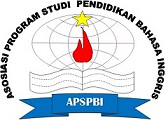STUDENTS’ CHALLENGES IN LITERATURE COURSES ONLINE LEARNING: STUDENTS’ PERCEPTIONS CASE STUDY
Abstract
Keywords
Full Text:
PDFReferences
Adami, M. F., & Kiger, A. (2005). The use of triangulation for completeness purposes. Nurse researcher, 12(4).
Ary, D. (2008). Introduction to Research in Education. Belmont: WADSWORTH Cengage learning.
Cakrawati, L. M. (2017). Students’ Perceptions on The Use of Online Learning Platforms in EFL Classroom. English Language Teaching and Technology Journal (ELT-Tech Journal), 1(1). 22-30.
Chen, C. Y., Pedersen, S., & Murphy, K. L. (2011). Learners’ perceived information overload in online learning via computer-mediated communication. Research in Learning Technology, 19(2).
Chen, T., Peng, L., Yin, X., Rong, J., Yang, J., & Cong, G. (2020, September). Analysis of user satisfaction with online education platforms in China during the COVID-19 pandemic. In Healthcare (Vol. 8, No. 3, p. 200). Multidisciplinary Digital Publishing Institute.
Coma, E., Medina, M., Méndez, L., Hermosilla, E., Iglesias, M., Olmos, C., & Calero, S. (2019). Effectiveness of electronic point-of-care reminders versus monthly feedback to improve adherence to 10 clinical recommendations in primary care: a cluster randomized clinical trial. BMC Medical Informatics and Decision Making, 19(1). doi:10.1186/s12911-019-0976-8
Coman, C., Țîru, L. G., Meseșan-Schmitz, L., Stanciu, C., & Bularca, M. C. (2020). Online Teaching and Learning in Higher Education during the Coronavirus Pandemic: Students’ Perspective. Sustainability, 12(24), 10367.
Davis, F. D. (1989). Perceived Usefulness, Perceived Ease of Use, and User Acceptance of Information Technology. MIS Quarterly, 13(3), 319. doi:10.2307/249008
Denzin, N. (2010). The Fundamentals. In An Introduction to Triangulation. Retrieved from http://www.unaids.org/sites/default/files/sub_landing/files/10_4-Intro-to-triangulation-MEF_0.pdf
Ege, P. D. (2017). Swot Analysis: A Theritical Review. The Journal of International Social Research, 10 (51). Doi Number: http://dx.doi.org/10.17719/jisr.2017.1832
Etikan, I. (2017). Comparison of Convenience Sampling and Purposive Sampling. American Journal of Theoretical and Applied Statistics. 5(1). 1-4
Ganesha, U.-T. U. (2017). Panduan Penggunaan E-Learning Universitas Pendidikan Ganesha. Singaraja.
Gregory, R. J. (2000). Psychological testing, history, principles, and applications (3rd ed.). Boston: Allyn & Bacon.
Holmes, B. & Gardner, J. (2006). E-Learning: Concepts and Practice, London: SAGE Publications. DOI: http://dx.doi.org/10.4135/9781446212585
Islam,M,S., & Ferdousi, S,A. (2019). Techno-Aide Google Classroom for Learning English: Prospects & Challenges. Journal on Today’s Ideas - Tomorrow’s Technologies, 7(2), 106-117. https://doi.org/10.15415/jotitt.2019.72006
Isik, A. (2012). Perception of Students and Teacher About The Use Of E - Learning/ Sharing Portal In Educational Activities. Middle East Technical University.
Jung, I. (2010). The dimensions of e-learning quality: from the learner’s perspective. Educational Technology Research and Development, 59(4), 445–464. doi:10.1007/s11423-010-9171-4
Lopez, S. J., & Louis, M. C. (2009). The Principles of Strengths-Based Education. Journal of College and Character, 10(4). https://doi.org/10.2202/1940-1639.1041
Koyan, I. W. (2012). Statistik Pendidikan Teknik Analisis Data Kuantitatif. Singaraja: Undiksha Press.
Mamattah, R. S. (2016). Students’ Perceptions of E-learning. Linkoping University.
Mason, R. (1998). Globalising Education: Trends and Applications (1st ed.). Routledge. https://doi.org/10.4324/9780203983287
McDonald, S. M. (2012). Perception: A Concept Analysis. International Journal of Nursing Knowledge, 23(1), 2–9. doi:10.1111/j.2047-3095.2011.01198.x
Rugg, D. (2010). An Introduction to Triangulation. Switzerland: UNAIDS.org.
Scarfone, K., Jansen, W., & Tracy, M. (2008). Guide to general server security. NIST Special Publication, 800(123).
Shojania, K. G., Jennings, A., Mayhew, A., Ramsay, C. R., Eccles, M. P., & Grimshaw, J. (2009). The effects of on-screen, point of care computer reminders on processes and outcomes of care. Cochrane Database of Systematic Reviews. doi:10.1002/14651858.cd001096.pub2
Supriadi, D., & Sa’ud, U. (2017). THE EFFECTIVENESS OF IMPLEMENTING INFORMATION AND COMMUNICATION TECHNOLOGY ON STUDENT ACADEMIC SERVICES (A Case Study in Bandung Institute of Technology for the 2015-2016 Period). International Journal of Education, 9(2), 139-148. doi:https://doi.org/10.17509/ije.v9i2.5478
Thompson, A. A. & Strickland, A. J. (1989). Strategy Formulation and Implementation, (4th Edition), USA: Irwin, Inc.
Utami, I. G. A. L. P., (2018). The Online Learning of Teacher Profession Education Program (PPG) for In-service English Teachers: Challenges and Accelerated Learning Factors. Jurnal Pendidikan Indonesia, 7(2), 145-153. DOI: 10.23887/jpi-undiksha. v7i2.15650
Zulfahmi MD, Sarwo. Taknduklangi, A. M. (2018). An analysis of Lecturer Perception on the Use of E-learning for English Instruction in IAIN Kendari. 3(2).
DOI: http://dx.doi.org/10.20527/jetall.v4i2.10352
Article Metrics
Abstract view : 422 timesPDF - 215 times
Refbacks
- There are currently no refbacks.
This journal is indexed in:


This Journal is listed in:
 Journal of English Teaching, Applied Linguistics and Literatures (JETALL)
Journal of English Teaching, Applied Linguistics and Literatures (JETALL)








.png)



1.png)
